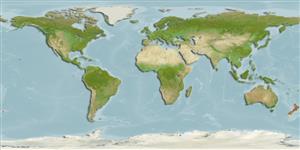>
Gobiesociformes (Clingfishes) >
Gobiesocidae (Clingfishes and singleslits) > Trachelochisminae
Eponymy: Richard ‘Dick’ Kenneth Dell (1920–2002) was Director, Dominion Museum (now Te Papa). [...] John ‘Jock’ Munne Moreland (1921–2012) was Curator of Fishes, Dominion Museum (now Te Papa), Wellington. [...] (Ref. 128868), visit book page.
More on author: Briggs.
Environment: milieu / climate zone / kisaran kedalaman / distribution range
Ekologi
laut dasar (demersal); kisaran kedalaman 0 - 15 m (Ref. 9003). Temperate
Southwest Pacific: endemic to New Zealand.
Size / Weight / umur
Kematangan: Lm ? range ? - ? cm
Max length : 8.5 cm TL jantan/; (Ref. 27207)
deskripsi pendek
Kunci identifiaksi (pengenalan) | Morfologi | Morfometrik
Duri punggung (Keseluruhan (total)) : 0; duri punggung lunak (Keseluruhan (total)) : 8 - 9; Duri dubur: 0; Sirip dubur lunak: 8 - 9. Head and body purple or cream with blue spots. A band of pale color across nape. Distinguished from other clingfishes by its thin lips, exposed flap of skin across the snout and a small fleshy swelling at the base of the pectoral fin.
Body shape (shape guide): elongated.
Occurs in rock pools and the subtidal zone. Usually found beneath the spines of sea urchins. Individuals too large to be associated with sea urchins usually found beneath rocks or among shell debris. Feeds mainly on the tube feet and pedicellariae of its host sea urchins, Evechinus chloroticus (Ref. 33548) and on small crustaceans.
Life cycle and mating behavior
Kematangan | Reproduksi, perkembang biakan | Pemijahan | telur-telur | Fecundity | Larva
Paulin, C. and C. Roberts, 1992. The rockpool fishes of New Zealand (Te ika aaria o Aotearoa). Museum of New Zealand (Te Papa Tongarewa). 177 p. (Ref. 9003)
Status IUCN Red List (Ref. 130435: Version 2025-1)
ancaman kepada manusia
Harmless
penggunaan manusia
Alat, peralatan
laporan khas
muat turun XML
Sumber internet
Estimates based on models
Preferred temperature (Acuan
123201): 12.6 - 18.5, mean 16.2 °C (based on 104 cells).
Phylogenetic diversity index (Acuan
82804): PD
50 = 1.0000 [Uniqueness, from 0.5 = low to 2.0 = high].
Bayesian length-weight: a=0.00457 (0.00179 - 0.01169), b=3.12 (2.89 - 3.35), in cm total length, based on LWR estimates for this (Sub)family-body shape (Ref.
93245).
Trophic level (Acuan
69278): 3.0 ±0.1 se; based on diet studies.
Daya lenting (Acuan
120179): sedang, Waktu penggandaan populasi minimum 1.4 - 4.4 tahun (Preliminary K or Fecundity.).
Fishing Vulnerability (Ref.
59153): Low vulnerability (10 of 100).
🛈
Nutrients (Ref.
124155): Calcium = 128 [68, 317] mg/100g; Iron = 0.486 [0.274, 0.973] mg/100g; Protein = 16.9 [15.7, 18.1] %; Omega3 = 0.472 [0.223, 1.003] g/100g; Selenium = 6.28 [2.51, 15.29] μg/100g; VitaminA = 46.3 [10.6, 191.5] μg/100g; Zinc = 1.16 [0.74, 1.75] mg/100g (wet weight);
